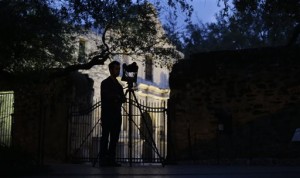

Associated Press
By MICHAEL GRACZYK
Associated Press
HOUSTON (AP) — The iconic west facade of the Alamo in downtown San Antonio is slowly eroding, a study by a team of Texas A&M-led architecture researchers using lasers and digital images shows.
The loss isn’t much: about 2 ½ inches over the past half-century, at the base of a column at the historic mission’s main entrance.
“Some might say that doesn’t sound like a whole lot, but over time, it adds up to a significant amount, especially if that rate increases in the future,” Robert Warden, director of the Texas A&M Center for Heritage Conservation, said in a web posting announcing the report.
The Alamo’s conservator, Pam Rosser, said Monday the 3-foot-thick limestone facade, arguably the most photographed historic site in Texas, isn’t in immediate danger, but the study that began four years ago provides more evidence of the need for preservation work.
“Their findings are not a surprise,” she said in an interview. “It’s an incredibly old building and this is just a really well-done bit of documentation.
“The stone has sort of worn away over time.”
The Alamo was established in 1718 by Franciscan priests as Mission San Antonio de Valero, and the current stone complex was built in 1744. In the 1800s, it was the site of a key battle in the Texas Revolution in which Texas gained independence from Mexico.
The researchers’ images from lasers, large-format cameras and other instruments were put together by computer software into a single package of two- and three-dimensional images to aid in development of a preservation plan. The results were compared with historical photos and documents.
“The bases were originally rectangular solids adorned with medallions or floral patterns that, if you look at them from the side, now look scooped, rather than straight,” according to Warden. “It’s clear from photos of the building in the 1930s that material loss was already well underway.”
The Alamo’s last extensive examination — and subsequent repairs and renovations — was in 1960.
When the stone mission was built, a plaster finish was applied to the facade and all other exterior walls to protect the limestone and mortar, Rosser said. But all maintenance stopped when the mission was secularized in the late 1700s.
“Over years and years it washed away and was never updated, I guess,” she said. “We just had this ongoing very slow deterioration.
“And then there was a battle here.”
Spanish soldiers in the early 1800s named the place after their hometown in Mexico, Alamo de Parras. It changed hands during the Mexican Revolution from Spain, then was taken over in December 1835 by Texian forces. An ensuing siege by Mexican forces ended March 6, 1836, when some 180 defenders — including Alamo commander William Travis, Davy Crockett and James Bowie — died. The Alamo late served as a store and outposts for Confederate and U.S. soldiers, before becoming the shrine it is today.
“There’s been so many … owners that have altered it in many different ways,” Rosser said.





